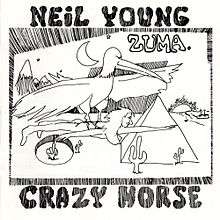Zuma (album)
| Zuma | ||||
|---|---|---|---|---|
 | ||||
| Studio album by Neil Young and Crazy Horse | ||||
| Released | November 10, 1975 | |||
| Recorded | June 16, 1974 – August 29, 1975 at Broken Arrow Ranch, Redwood City, CA and Pt. Dume, CA | |||
| Genre | Folk rock, country rock, roots rock, hard rock[1] | |||
| Length | 36:34 | |||
| Label | Reprise | |||
| Producer |
Neil Young, David Briggs Neil Young, Tim Mulligan "Pardon My Heart," "Lookin' for a Love," and "Through My Sails" | |||
| Neil Young chronology | ||||
| ||||
| Professional ratings | |
|---|---|
| Review scores | |
| Source | Rating |
| Allmusic | |
| Robert Christgau | A−[2] |
| Pitchfork | 8.7/10[3] |
Zuma is the seventh studio album by Canadian musician Neil Young, released on Reprise Records in 1975. Co-credited to Crazy Horse, it includes "Cortez the Killer," one of Young's best-known songs. It peaked at #25 on the Billboard 200, and has been certified a gold record by the RIAA.[4]
Background
The death of guitarist and bandmate Danny Whitten from a drug overdose in 1972 affected Young greatly, and left the Crazy Horse band without its leader and songwriter. Young went out on tour in late 1973 with a band dubbed the Santa Monica Flyers, composed of the Crazy Horse rhythm section of bassist Billy Talbot and drummer Ralph Molina along with guitarist Nils Lofgren, who had played on Crazy Horse's debut album, and multi-instrumentalist Ben Keith, this group recording most of the tracks for what would be his Tonight's the Night album. After the 1974 stadium tour with Crosby, Stills & Nash and another abandoned attempt at the second CSNY studio album, Young formed a new version of Crazy Horse in 1975 with guitarist Frank Sampedro slotted in alongside Talbot and Molina. This line-up first appeared on this album, and has remained stable to the present day.
Content
Zuma was the first album released after the famed Ditch Trilogy, comprising the albums Time Fades Away, and On the Beach, and Tonight's the Night. Young wrote most of the songs in Zuma during his time living on Sea Level Drive in Malibu, California. though "Through My Sails," originally entitled "Sailboat Song," derives from the spring 1974 rehearsals with CSNY, featuring the quartet on vocals and "Pardon My Heart" was recorded around the same period, originally intended to be released as part of Homegrown.
The melody and lyrics of "Don't Cry No Tears" are partially derived from "I Wonder", a song Young wrote in high school which appeared in his Archives in 2009. Young has claimed during a show in 1996 that he'd also written "Cortez the Killer" in high school while suffering "Montezuma's Revenge."[5] The song ends with a fade out because the original cut stopped abruptly due to a power surge, and a final verse Young had written was not recorded. Young's reaction to hearing of this was, "I never liked that verse anyway", and it has never been performed live.[6]
"Danger Bird" interpolates sections of an unreleased song relating to Young's breakup with Carrie Snodgress called "L.A. Girls and Ocean Boys", specifically the line "'Cause you've been with another man / there you are and here I am."[7] Lou Reed once told an interviewer that he felt Young had become a "great guitarist" during this period, specifically citing "Danger Bird" as an example.[8]
Track listing
Side one
| No. | Title | Writer(s) | Length |
|---|---|---|---|
| 1. | "Don't Cry No Tears" | Neil Young | 2:34 |
| 2. | "Danger Bird" | Neil Young | 6:54 |
| 3. | "Pardon My Heart" | Neil Young | 3:49 |
| 4. | "Lookin' for a Love" | Neil Young | 3:17 |
| 5. | "Barstool Blues" | Neil Young | 3:02 |
Side two
| No. | Title | Writer(s) | Length |
|---|---|---|---|
| 1. | "Stupid Girl" | Neil Young | 3:13 |
| 2. | "Drive Back" | Neil Young | 3:32 |
| 3. | "Cortez the Killer" | Neil Young | 7:29 |
| 4. | "Through My Sails" | Neil Young | 2:41 |
Personnel
- Neil Young — vocals, guitars
- Frank Sampedro — rhythm guitar all tracks except "Pardon My Heart" and "Through My Sails"
- Billy Talbot — bass all tracks except "Pardon My Heart" and "Through My Sails"; backing vocals all tracks except "Through My Sails"
- Tim Drummond — bass on "Pardon My Heart"
- Ralph Molina — drums all tracks except "Pardon My Heart" and "Through My Sails"; backing vocals all tracks except "Through My Sails"
- Stephen Stills — bass, backing vocals on "Through My Sails"
- David Crosby, Graham Nash — backing vocals on "Through My Sails"
- Russ Kunkel — congas on "Through My Sails"
References
- 1 2 Ruhlman, William. Neil Young: Zuma > Review at AllMusic. Retrieved 30 November 2005.
- ↑ Christgau, Robert. "Neil Young: Zuma > Review". Robert Christgau. Retrieved 10 March 2006.
- ↑ Pitchfork review
- ↑ RIAA database retrieved 23 August 2014
- ↑ Rolling Stone song facts check retrieved 23 August 2014.
- ↑ Songfacts website retrieved 23 August 2014
- ↑ Jimmy McDonough. Shakey: Neil Young's Biography. New York: Random House, 2002, pp. 488-506. ISBN 0-679-42772-4
- ↑ ThrashersWheat.org page: "Jammin' with Neil Young: Influences and Musical Collaborations; Other Artists."
External links
- "Neil Young With Crazy Horse – Zuma". Discogs.
- Zuma at Myspace (streamed copy where licensed)
